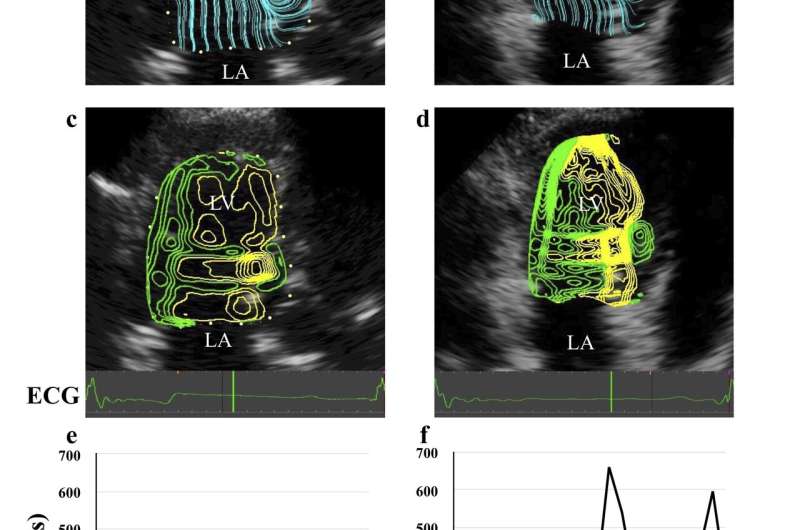Small hearts have strong vortex flow, large hearts have mild vortex

An international collaboration led by veterinary scientists at Tokyo University of Agriculture and Technology (TUAT), Japan, has found that size of a dog heart affects both vortex flow and pressure difference in the heart, which both are promising as an index of diastolic function. Their findings mean that size correction of vorticity and pressure difference allows us to use these indexes in the field of pediatric and veterinary medicine. Their findings were published in Scientific Reports on January 24th, 2020.
The heart works through 2 steps, contraction (medical term: systole, systolic) and expansion (medical term: diastole, diastolic), to circulate blood to the whole body. Diagnosis of its systolic dysfunction is relatively simple by using echocardiographic examination. In contrast, its diastolic function is far more complex despite the fact that patient numbers of systolic dysfunction are about the same as those of the diastolic dysfunction. "We have to measure the diastolic function precisely by a catheter inserted in the heart," said Ryou Tanaka, Professor in the Department of Veterinary Surgery, Faculty of Veterinary Medicine, TUAT, and corresponding author of the paper. "So, we need to develop a noninvasive technique for measuring the diastolic function, which should be simple and reliable."
The heart expands using energy and acquires blood by creating a negative pressure in the heart. Blood entering the heart in response to the pressure difference creates a vortex in the left chamber. Currently, a method called vector flow mapping (VFM) using echocardiography allows us to visualize and quantify the vortex flow in the heart. Their previous study found that the vortex flow in the left lower chamber (called the left ventricle) was stronger if the pressure was more different. Hence, both the vortex flow and the pressure difference in the left lower chamber when the heart expands could be markers for the diastolic function. It is noted that if the diastolic function becomes weaker, blood congestion tends to lead symptoms of heart failure such as shortness of breath.
"We started wondering whether or not the diastolic function of children's hearts, which is much smaller than adults' hearts, could be evaluated by these 2 indices—that is, the vorticity and the pressure difference," said Katsuhiro Matsuura, D.V.M., Ph.D, the first author of the paper and a postdoctoral fellow in the Department of Veterinary Surgery of TUAT. "We then hypothesized that an additional index must be required when the heat sizes are so different. To test this hypothesis, we chose adult dogs instead of observing hearts of healthy children and adults," adds Matsuura. This is because the function of the heart itself changes during growth. Dogs are very different in body size within the same species and the body weight of adult dogs is very different, for example, from 1 kg to 80 kg.
"We examined flow dynamics in the heart of 58 healthy adult dogs (1.3 to 42.3 kg in weight) by VFM. We then found that the heart size is positively correlated with the pressure difference and inversely correlated with the vortex flow," Matsuura explained. "Our findings indicate that to non-invasively diagnose cardiac function using indexes of flow dynamics the heart size should be taken into account. Now that we can extend this non-invasive method to human pediatrics and veterinary medicine, and our next step is to study fluid dynamics in diseased cases," according to Tanaka.
More information: Katsuhiro Matsuura et al, Changes in left ventricular blood flow during diastole due to differences in chamber size in healthy dogs, Scientific Reports (2020). DOI: 10.1038/s41598-019-57180-6



















